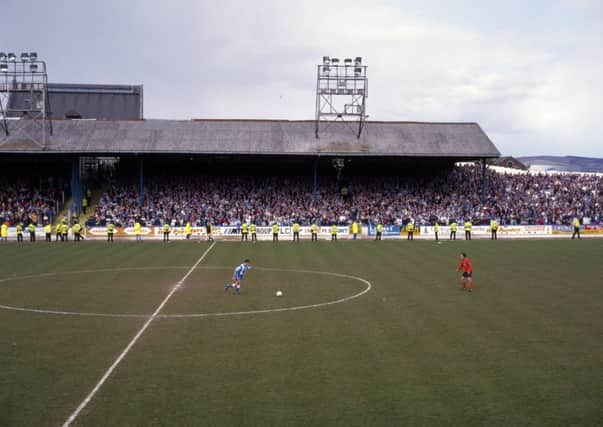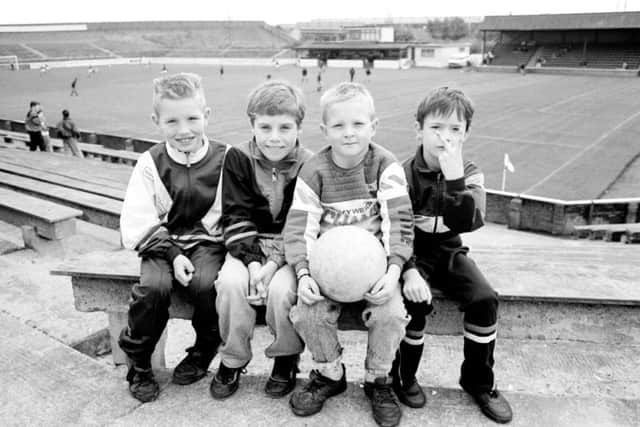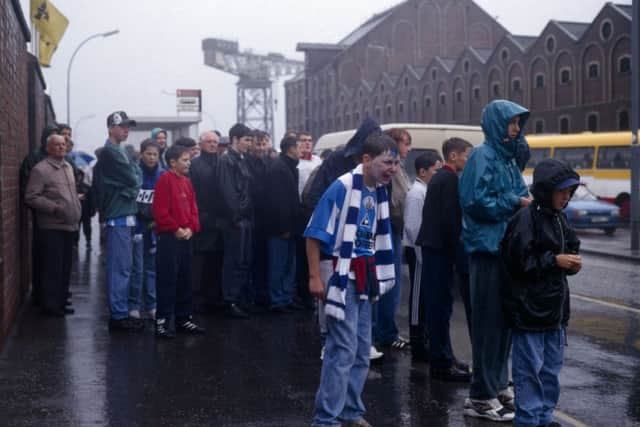Stuart Roy Clarke on The Homes Of Football


The picture above is not a trick. There really was a mass occupation of the Dundee United penalty area when Morton hosted the Arabs in a Scottish Cup tie in 1996, leaving the centre of the pitch occupied by only two players. Such a situation may be commonplace when a team has a free kick from this range but Stuart Roy Clarke came out of his dark room that day with a photographic vision for what he describes as his “apocalyptic fear”.
With a style that sets him apart, Clarke has spent two decades capturing the British football experience on film. Many of his images are bleak and dark but if it is possible to be beautiful and ugly at the same time, they achieve this distinction.
Advertisement
Hide AdAdvertisement
Hide AdA Watford fan from Hertfordshire, he has spent enough time at grounds north of the Border to have a deep affinity and affection for Scottish football. In the latest instalment of his Homes Of Football series, entitled Where The Heart Is, he features some images from grounds that are still standing, and some, such as Firs Park and Kilbowie, that are not. But clapped-out Cappielow is where he inadvertently created a metaphor for the game’s plummeting status.


“Cappielow is probably my favourite ground,” says Clarke. “I seem to get pictures there standing on my head, and the only other ground where I feel like that is Sunderland. I just seem to have luck there. The way I have framed my picture from that Morton-Dundee United game, it looks like it’s one-a-side. That was my apocalyptic fear about Scottish football: that it would end up reduced to that; that over the years the crowds would dwindle, and the competition would dwindle and it would end up a very reduced version of something that was once very vibrant.”
Clarke will be here in person to elaborate on these fears early next year when his latest work is unveiled. He has been commissioned by the Scottish Government, at the request of Scottish Supporters Trust head Paul Goodwin, to take a series of images of fans from all 42 SPFL clubs. The Scotsman has seen a sample of the pictures and they are mind-bogglingly good, and will feature on these pages soon as well as in exhibition halls around the country.
Clarke’s pictures capture the mood and more often than not it is a sombre, despondent mood that makes you wonder why fans of clubs whose only achievement is survival go back. Especially on weekends when the weather is as biblical as it was on Saturday past.
Clarke has spent many a journey to and from his home mulling over this curious form of fidelity, and his theories frame his work.


“For me, the essence of it is that we take our fandom to some extreme levels, but not too far. If you are going to capture that and arrive at a positive ending, like some of the films that have been made about life in Great Britain today, you’ve got to hit hard on some of the problems and some of the fed-up-ness to come out with a joyous ending,” he says.
“We plod the streets in the rain, going to matches that are often completely forlorn, and still we find something there and find a reason to go back. Hardly anyone ever wins anything, perhaps even more in Scotland than in England – at the minute there is only one club that can win the league, and for many years it was only one of two clubs that could.
“Most of this is about loyalty, it’s about weather and it’s mostly about disappointment, and the fact that still we go back and sign up for another lot of punishment. Some of the people are charmingly loyal.”
Advertisement
Hide AdAdvertisement
Hide AdClarke has not yet been to every ground in Scotland but he is particularly fond of Recreation Park in Alloa and Gayfield in Arbroath, as well as Greenock’s Cappielow.
“I went to Alloa and had a great time there both times, and I didn’t expect that. I didn’t expect it to be so positive,” he says.
“There are quite a lot of derbies in Scotland, and Alloa-Stirling was the one I saw there, and the banter was great between the fans.
“I still haven’t gone to Stranraer but I know what will happen when I do: I will find one fan whose fandom I will fall in love with and then I will think of them every time I see Stranraer’s results.
“I went to Arbroath to do a match in September, when the weather was still quite good, and the first time I went there 20 years ago I was pinching myself because it was fishes coming over the wall with the waves and throw-ins being blown backwards, and I just smiled and thought: ‘I can’t wait to get back for another match.’”
Clarke’s popularity has grown with his reputation, and he has had some amusing brushes with fame. He writes in the book that when Robbie Williams played at Glasgow’s Barrowlands, he invited Clarke to meet him pre-gig and loved his pictures so much that he took possession of one of them.
“I came up to Scotland a lot in the mid-Nineties, and then in the last year I’ve come back because I’ve been working on this new project for the Scottish Government and the Scottish Supporters Trust. But I always had a good feel for Scottish football because I lived in Carlisle for 30 years and every weekend I would be sent to a football match and it could be on one side of the Border or the other,” says Clarke. “Coming back this year I thought it was a chance to see the game up here with fresh eyes, and to remember what I liked so much about it all those years ago.
“The point of the project is to show the wealth of fandom – that’s the positive way of looking at it. There have been some issues with fans of late and I think they like my style, which is very positive.”